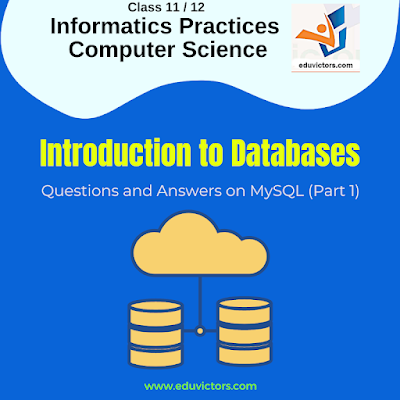Class 11 Informatics Practices
Introduction to Databases
Questions and Answers on MySQL
(Part 1)
Q1. What is database?
Answer: A database is an organized collection of data. The data are typically organized to model aspects of reality in a way that supports processes requiring this information. The term "database" can both refer to the data themselves or to the database management system.
Q2. What is database management system (DBMS)?
Answer: The Database management system is a software application for the interaction between users database itself.
Q3. What is relational database management system (RDBMS)?
Answer: The software used to store, manage, query, and retrieve data stored in a relational database (in form of tables) is called a relational database management system (RDBMS).
The RDBMS provides an interface between users and applications and the database, as well as administrative functions for managing data storage, access, and performance.
Q4. Give two examples of RDBMS?
Answers:
1. Oracle - commercial
2. MySQL - open source, freeware
3. Microsoft SQL Server - commercial
Q5. Is MySQL a client server based RDBMS?
Answer: Yes, the MySQL database system uses a client-server architecture. The server, mysqld, is the program that actually manipulates databases.
The client applications (e.g. mysql) interact with the server using structured query language (SQL).
Q6. What are the important features of MySQL?
Answer:
Features of MySQL:
1. Released under open source and available free of cost.
2. Easy to learn and use..
3. Fast processing speed and easy in installation. Occupy very less space.
4. Supports standards based SQL.
5. Provides portability.
6. High Security.
7. Provides many data types.
8. Handles large database.
Q7. What is SQL?
Answer: SQL stands for Structured Query Language. It lets you access and manipulate databases. SQL became a standard of the American National Standards Institute (ANSI) in 1986, and of the International Organization for Standardization (ISO) in 1987.
Q8. What Can SQL do?
Answer:
1. SQL can execute queries against a database
2. SQL can retrieve data from a database
3. SQL can insert records in a database
4. SQL can update records in a database
5. SQL can delete records from a database
6. SQL can create new databases
7. SQL can create new tables in a database
8. SQL can create stored procedures in a database
9. SQL can create views in a database
10. SQL can set permissions on tables, procedures, and views
Q9. What are the rules we follow while writing SQL statements?
Answer:
1. SQL is case insensitive. That means name and NAME are same for SQL.
2. Always end SQL statements with a semicolon (;).
3. To enter multiline SQL statements, we don’t write ‘;’ after the first line. Press enter key to go to next line and continue writing the statement. Write ‘;’ in the end of last line and then press enter key.
Q10. Write the steps to start MYSQL server from command line?
Answer: Open Command Shell/ DOS Window. (cmd.exe)
Then type the following command, the server will ask the password. Enter the correct password and MySQL server will start.
% mysql -h localhost -u root -p
Enter password: ******
Q11. Name the categories SQL commands are divided into.
Answer: SQL commands are divided into the following categories:
1. Data Definition Language (DDL)
2. Data Manipulation Language (DML)
3. Data Control Language (DCL)
4. Transaction Control Language (TCL)
5. Data Query Language (DQL) - Sub-Part of DML
Q12. What is Data Definition Language?
Answer: DDL: Data Definition Language
SQL Commands that allow you to perform tasks related to data definition i.e creation, alter and deleting the structure of tables and database. e.g :
- Create Table
- Drop Table
- Alter Table
- Create Database
- Drop Database
Q13. What is DML?
Answer: DML stands for Data Manipulation Language.
SQL Commands that allow you to make changes in the data of the table. e.g:
- Update
- Delete
- Insert Into
Q14. Define the following terms:
i. Relational Data Model
ii. Relation
iii. Domain
iv. Tuple
v. Attribute
vi. Degree
vii. Cardinality
viii. View
Answer:
i. Relational Data Model
In this model data is organized into tables i.e. rows and columns. These tables are called relations.
ii. Relation
Table in relational database
iii. Domain
Pool of values from which the actual values appear.
iv. Tuple
A row/record of a relation or table
v. Attribute
A column/field of relation
vi. Degree
Number of attributes
vii. Cardinality
Number of tuples/rows/records
viii. View
Virtual table that does not really exist in its own right.
👉See Also:
Worksheet on Database Management Systems
Database Concepts (Important Terms)


No comments:
Post a Comment
We love to hear your thoughts about this post!
Note: only a member of this blog may post a comment.